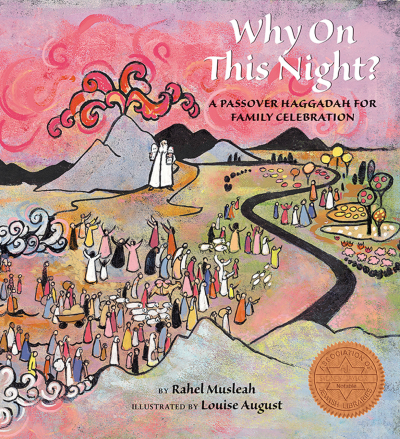Rahel Musleah
Illustrated by Louise August
Why on This Night?
A Passover Haggadah for Family Celebration
Moosic, Pa., Kalaniot Books, 2024, ISBN: 9798986396552
Reviewed by Rochelle Strauss1
My earliest memory of participating in my extended family's Passover seder was when I was about eight years old. It's a favorite memory, because my sister and cousins picked me to steal the afikomen from our Zayde (grandfather), the family patriarch. I went under the table to crawl to his end where he sat on a pillow. When I reached him, his hand was under the table, holding the afikomen for me to take. Our participation as children was to say the ma nishtanah (the four questions) and steal the afikomen. The haggadah was read in Hebrew, we sang, we ate, and for the two seders, we sat together as a family; now we are dispersed geographically and among our nuclear families. Our children and grandchildren changed the simple recitation of the haggadah into a participatory event. They shared lessons from school, asking questions, offering explanations, and decorating to enliven the family gathering.
“Why On This Night?” is a family haggadah that is a more contemporary addition to the Passover seder. The recipes, songs, games, crafts, poetry, and play are suggested enhancements to everyone’s experience. The haggadah text is in Hebrew, English translation, and transliteration to broaden the accessibility to a diverse audience of various levels of religiosity.
The preparations for the holiday are noted as equally important; the significance of cleaning our homes, removing chometz, and changing all eating and cooking utensils is explained. The items needed for the seder are listed in detail, from setting the table to preparing the seder plate. Recipes for charoset and sample seder meals are choices from different traditions, such as Ashkenazic and Sephardic. A fun pre-seder activity is making decorations, and a few ideas are illustrated with instructions.
After the candle lighting blessing to begin the holiday, the order of each step of the seder is listed with a brief explanation. This book is not an annotated traditional haggadah, instead, each major section is excerpted in Hebrew, English translation and transliteration. The excerpts are annotated, with more terms and activities clarified; for example, the washing of hands, eating from the seder plate, saying the plagues, etc. The Talmud tells us that every generation should view themselves as if they personally left Egypt, and to tell this story to every generation. The author tells this story of the exodus in the form of a play. Contemporary references to the theme of freedom are included with the airlift of Ethiopian Jews, a poem by Elie Wiesel, and the Holocaust as examples. Another theme of the haggadah is to explain what it means to become “K'lal Israel,” or a united Jewish community; the author uses stories and references to social services to encourage a social conscience with the help of this book.
Children, in fourth grade and up, can use this haggadah to follow along with a traditional text, then share the poems, songs, insights, or explanations at various parts of the seder. The author, Rahel Musleah, writes simply to appeal to the younger participants. Three contemporary songs set to familiar melodies: a song about Jacob to “Yankee Doodle,” the birth of Moses to “Sing a song of sixpence,” and Moses' plea to Pharaoh to“ B-I-N-G-O,” are easy to learn and fun to sing. They are sung during the exodus play, a narration of events, voiced by Moses, Pharaoh, and others, and would be interesting to read or perform. A Conservative movement haggadah was used for most of the Hebrew text. The author updated the previous 2000 edition, but I do not know what was revised. Included is a key to the pronunciation for the transliterations. Also, Ms. Musleah offers advice on how to use this haggadah to meaningfully enhance the experience of each participant.
The text is illustrated by Louise August. The technique is described as lino, or linoleum, cuts printed in oil on rice paper with other multimedia treatments. The colors are deep and black outlines the forms. The images have a Middle Eastern influence. They complement the text with both descriptive images, such as the exodus, and imaginative designs that enliven other pages. The page with the seder plate is especially colorful and decorative with each item clearly arrayed on the plate. The book is well designed and the fonts for Hebrew and English are easy to read.
This Passover, when my family gathers for the seders, I will share this family haggadah with my grandchildren. The oldest, at seven and a half, will probably be allowed to participate past her bedtime. In addition to selecting what we would add to the service, the children’s songs and crafts can be enjoyed separately from the seders. With the help of this book, I am looking forward to enlivening old traditions while creating new ones.
1 Rochelle Strauss is a retired librarian, Brooklyn Public Library, New York
Copyright by Sephardic Horizons, all rights reserved. ISSN Number 2158-1800

